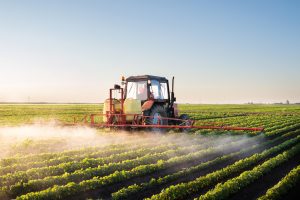In its revisions to the Worker Protection Standard ((WPS), November 2, 2015, Federal Register (FR)), the EPA introduced a new term—application exclusion zone (AEZ). AEZ replaced entry restricted area, a phrase included in the Agency’s proposal under which people other than approved pesticide handlers were prohibited from entering both outdoor areas treated with pesticides and zones around treated areas.
In contrast, the AEZ is a no-entry zone surrounding application equipment. Since application equipment typically moves, the AEZ must also move. While the AEZ would generally be smaller than an entry restricted area, compliance with the AEZ requirement is more complex, particularly when the AEZ extends beyond the agricultural establishment.
Size of AEZ
The size of the AEZ varies depending on type of application and other factors, including droplet size and height of nozzles above the planting medium. The AEZ is 100 feet (ft) for aerial, air blast, fumigant, smoke, mist, and fog applications, as well as spray applications using very fine or fine droplet sizes (a volume median droplet diameter less than 294 microns). An AEZ of 25 ft is required when the pesticide is sprayed using medium- or larger-sized droplets more than 12 inches above the plant medium. Applications that do not fall into either of these categories do not require an AEZ. If a pesticide is applied aerially, the border of the AEZ is a horizontal circle that extends 100 ft from the place on the ground directly below the aircraft; the circle moves as the aircraft application proceeds.
Suspension of Application
The pesticide handler must suspend application if any person is anywhere in the AEZ. This requirement is not limited to the agricultural establishment; rather, it applies to any area on or off the establishment within the AEZ while the application is ongoing
The requirement for the agricultural employer to keep persons out of the AEZ applies only within the boundaries of the establishment because the agricultural employer cannot be expected to control persons off the establishment.
However, the suspend-application provision does apply beyond the boundaries of the establishment because the applicator and employer do have control over the pesticide application and are subject to a WPS requirement to apply the pesticide in a way that will not contact persons on or off the establishment. In other words, if persons are in the AEZ outside the boundary of the establishment, the applicator must suspend application. The only person(s) allowed within the AEZ during application is the appropriately trained and equipped handler(s) involved in the application.

Resuming Application
If the AEZ stretches beyond the property of the agricultural establishment being treated and a worker or other person is in this portion of the AEZ, the applicator must temporarily suspend the application and may not proceed until the applicator can ensure that the pesticide will not contact any person in the AEZ that extends beyond the boundary of the establishment. The final WPS does not state when the handler may resume a pesticide application if the application was suspended because persons were in the AEZ but off the establishment. However, the EPA has issued an interpretative policy that states:
“Before resuming the application when workers and other persons are in the AEZ but located off the establishment, the handler must take measures to ensure that such workers and other persons will not be contacted by the pesticide application either directly or through drift. Examples of such measures include assessing the wind and other weather conditions to confirm they will prevent workers or other persons from being contacted by the pesticide either directly or through drift; adjusting the application method or employing drift reduction measures in a way to ensure that resuming the application will not result in workers or other persons off the establishment being contacted by the pesticide; asking workers or other persons to move out of the AEZ until the application is complete; or adjusting the treated area or the path of the application equipment away from the workers or other persons so they would not be in the AEZ. The handler may resume the pesticide application when a worker or other person is in the AEZ only if the handler can ensure that it can be carried out in compliance with all of the pesticide’s applicable labeling requirements and restrictions, and that workers and other persons on and off the establishment will not be contacted by the pesticide as a result of the application except as may be permitted by the pesticide’s labeling.”
Training resources for the WPS are at the EPA-approved site, http://pesticideresources.org/wps/inventory.html.

